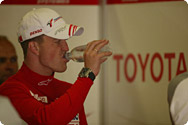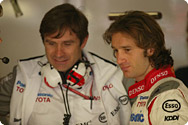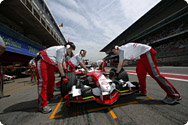As always, thank you for your support. Here is my report from the Spanish Grand Prix, the second GP race in as many weeks, and the sixth race of the season.
A circuit known for being cruel to both engines and drivers
I'm sure you must have been wondering about the engine troubles that forced Ralf to retire from the European Grand Prix last week. I can tell you that things could have been worse. We were fortunate that the engine did not fly apart, so we were able to recover the broken parts, and devise the proper response to the issue.
 |
 |
| Dealing with the long straight at the Catalunya Circuit, the 2.4 liter engines mandated for 2006 have lost about one second off pole time compared to last year's 3 liter engines. With higher cornering speeds compared to last year, the drivers are experiencing greater physical punishment. |
|
Meanwhile, Jarno Trulli had issues last week with his car underperforming during the first stint. We were able to pinpoint the cause as tire pressure settings. During the first stint, the tires were slightly harder than optimal (due to higher air pressure). We believe that after the safety car came out and changed the pace, Jarno's car fell out of balance, negatively affecting performance. The lack of performance was due to our inability to properly control this aspect of the car.
While we have participated in several testing sessions here at Barcelona, this year we are bringing a 2.4 liter V8 engine, which means that top speeds will be slower than in prior years. Last year we were up around 320 to 330 km/h on the straight, but I don't think we'll match that this year. Even so, our most recent tests have us projecting that the quicker cars will lap at around 1 minute 14 seconds, which is the pace that won the pole last year.
| |
 |
 |
While tire pressure settings were cited as the cause behind the underperformance of Trulli's car at the European Grand Prix, the balance on Jarno's car changed with every stint here at the Spanish Grand Prix, once again forcing him off pace. |
 |
Top speeds might be lower, but lap times are as fast as ever. What this means, of course, is that we now have higher cornering speeds. This course has a long straight, requiring extended time on full throttle. This increases the burden on the engine. And since cornering speed is higher, the drivers are also under an increased physical strain.
As with last week's race, we haven't made any outwardly noticeable aerodynamic changes. We have been improving the engines incrementally, but there are no major changes to speak of.
Finally, a free practice with no troubles. Completing a smooth program.
Due to the rain, we only ran some installation laps (checking car functions) during the morning practice. We sailed through our program without any issues during the afternoon. With no particular troubles to mention, "smooth" was the watchword of the day. While we have had some issues during practice the last few races, I think today's performance was more typical of Panasonic Toyota Racing.
The cars are basically under the same settings as when we unloaded them from the trucks. We did make some slight spring adjustments and fidget with the camber, but there were no team discussions about making significant weight distribution adjustments or wing changes. All in all, things ran very uneventfully.
Both cars made it to Q3 (final session) during Saturday qualifying, and our goal was to finish near the top position in Sunday's race. Everything on Friday indicated we should be able to accomplish our goals.
A smooth, but "half-satisfying, half-dissatisfying" qualifying
In a word, I have to say that we are only "half-satisfied" with qualifying results. Both cars ran fine during the morning, and we felt we had the potential to qualify higher on the grid that we did. In that sense, we are "half-dissatisfied."
Right from Friday, our cars were performing well, and we built up a number of trouble-free laps Saturday morning. Both Q1 (first qualifying session) and Q2 went exactly as planned. During Q3, we held off until the very last minute to change tires, and our resulting lap times were almost exactly on target. If tire changes had been even ten seconds later, we would have been too late.
 |
 |
| With both cars starting in the top 10, Panasonic Toyota Racing achieved their goals for qualifying at the Spanish Grand Prix. But Arai DTC reflected, "I think we could have made some more adjustments to improve during Q3," indicating that the team could possibly have qualified even higher. |
|
Jarno was suffering from a bit of understeer, so we made front wing adjustments as he made his way through qualifying. I get the feeling that maybe we should have made a few more adjustments during Q3. I think an added wing adjustment could have allowed us to attack a bit more aggressively, and Jarno could have qualified closer to Ralf, perhaps even better.
Ralf seemed to be unhappy with the performance of his car in the third sector, so I think Ralf might have had a chance to be quicker, too. At any rate, Ralf turned in the exact same lap time as the P5 qualifier. These are a few of the reasons that we were "half-dissatisfied." We feel that we could have done better.
In any event, both cars performed well over the first two days, and both made it through to Q3. For us, "I wish we would have." is a phrase left in the past, and I really do think we performed well.
Expecting to improve position, we were dealt an unexpected result
I suppose I should address what happened at the start of the race first. We had hoped that we would be able to move at least one position up from P6 and P7 at the start, but contrary to expectations, both cars fell back in position, making for an even more difficult race. Jarno had troubles with constantly changing car balance, which effectively stymied his attempts to increase his pace.
After the start, Jarno and Ralf touched, but I would write this down as a "racing accident." For our part, once we put the drivers out on the course, our instructions are "do you best." We can't control the drivers from pit lane. Jarno didn't "shut the door" or do anything like that, so really the accident was just one of those things that happen during a race.
| |
 |
 |
Falling back at the start, the cars never completely recovered during the race. While Ralf had no issues with pace, he was doubly unlucky, experiencing both an inadvertent touch with his teammate and electrical system troubles. Panasonic Toyota Racing hopes that the introduction of the TF106B at the next race will turn around their F1 series fortunes. |
 |
Ralf had no pace issues at all. Even after loading fuel at the first pit stop, he was able to get right back on pace. Unfortunately-and I don't think this had anything to do directly with his bump with Jarno-Ralf encountered electrical problems that prevented his gears from working. That was the issue that forced Ralf to retire from the race.
Meanwhile, Jarno was fighting balance problems with his car. During the first stint, Jarno complained of oversteer. The problem stabilized after the first or second lap in the second stint, but the problem cropped up again in the third stint. Jarno experienced similar troubles in the previous race, so this was really an unexpected development for us.
You can be sure that we will thoroughly investigate this issue before Monaco. We can't have a car that changes balance with every stint. We will be bringing the newly modified TF106B to Monaco. Our test drivers have reported back to us that front performance has improved for this iteration.
Right now, it looks like Renault and Ferrari have separated from the pack, but we are going to do everything in our power to catch them.
I hope you cheer us on at Monaco.
|